
Recently on Cyclingnews.com |
Tour of California Feature, February 20, 2009
Tour director: Charting the course for Tour of California
Often labelled 'travelling circuses', stage races are hard work. Just ask Medalist Sports' Chuck Hodge, he's the man in charge of the Tour of California, America's biggest travelling circus when it comes to cycling. Cyclingnews' Mark Zalewski discovers what the 'man behind the curtain' does to make everything tick.
A lot goes into putting on a successful stage race from funding to publicity to ensuring everyone has a place to sleep. Everything is done with one goal mind: making the race happen each day. And when the starting gun sounds, the responsibility for success rests largely on one person's shoulders, the race technical director. For the biggest races in North America Tour of California, Tour of Missouri, Tour de Georgia that person is Chuck Hodge.
An entourage of vehicles follow racers from one city to another in parade fashion, escorted by police and officials in an 'ad hoc ballet' to ensure both safety and a viable competitive arena. Without a technical director there's a distinct possibility that it isn't going to happen.
Hodge oversees the daily race operations but the planning arguably the most important aspect occurs upwards of a year in advance for races such as the Tour of California. And a lot more goes into it than just picking two points on a map. "Everyone thinks that we just pick the start and finish and then go where we want," begins Hodge. "But there are a huge number of considerations everything from the hotel situation to the transfers to the economics of the bid package. Combining all those factors we hope that everything comes out in the end," he explains.
"We had a tree fall in front of the race in Georgia. We've had high-speed chases come at the race before. So far we've handled everything without the riders having to stop."-Chuck Hodge lists off a few close calls he's dealt with. |
"For Missouri, we would have liked to have a really hard stage the day before the finish. But it didn't work out that way. When you look at where we had to go politically, where our sponsors wanted us to go... we ended up with the hardest stage in the middle. But it still worked out."
"We generally start a year before," says Hodge of planning the race route. "At a race we will have representatives for next year's prospective cities attending the race, which is good because it shows them what is going on and what is involved.
"After the year starts we begin soliciting bids from the cities. I am only involved in that to the extent of whether it is feasible to go from point A to point B. We have looked at cities and then get cracking on the maps only to realise we can't go between them. After that is when I really begin to look at routes and locations in cities for start and finish lines."
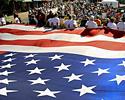 |
At this point the technical director needs to be in contact with various agencies; from the largest state level down to the smallest municipality and even private agencies, as the courses are developed.
"It starts with me, our race director, and in places like California, Eric Smith. All of us start mapping possible courses out. We use local knowledge as well, including cyclists. Generally we will have two or three options. Once we decide on one we will go and do a very detailed log of it, showing every intersection and possible issue. Then we go to the various agencies involved to get approvals and what needs to be done."
Hodge makes the point that, "Each state is different. With California much more detailed [is necessary], requiring much more manpower. But [the California Highway Patrol] and CalTrans have been great, though a little more bureaucratic!"
Anticipating every need
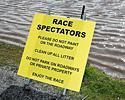 |
Hodge also illustrates the extent of the organisation required, not just on the road but around it. "Some of the big things are outside of the actual race caravan. It's things like parking, transfers, directions, rules and trying to anticipate all those things so that you can spend your time running the race," he says. "We try to think like a team manager and anticipate what they will need."
To say that every detail matters would be an understatement; no matter how seemingly insignificant. A railroad crossing (referred to as a level grade in tech. director speak) can pose a problem if the crossing is not so level, which does not mix well with road bike wheels. But an even bigger problem is if the gates are down when the race approaches.
"We even make contacts with the railroads. In Georgia we have a great contact that attends all of our meetings. In California, it's the BNSF and I've made contact with them. One of my nightmares is when we have tracks on a finishing circuit and have a train coming across, pulling a Paris-Roubaix on us!"
Expect the unexpected
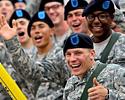 |
Hodge will be the first to say that he is just one of many people that makes the race happen each day. But if something goes wrong on the road everyone looks to him first. As such, he needs to stay in constant contact with those responsible.
"I usually only run about four radios," Hodge said laughing. "[I listen to] our caravan channel to communicate with the drivers; the police radio; then I listen in on the officials and radio tour, but those are the lower priority."
It's two-way communication, however; while listening, Hodge needs to manage situations ranging from emergencies to the mundane. And of course, he has a laundry list of stories from his years on the road.
"We've had a few issues in the past," says Hodge, smirking. "Going into St. Charles the roads we are using were under water a few weeks before [the Tour of Missouri]. We have steel bridges to go over, but we try to at least know about it beforehand and cover things like that with carpet. A couple of days before I got a call from someone at Fort Leonard Wood who had misinterpreted an email and thought we were coming in a couple of hours earlier than we were. But it is all about the dialogue we have beforehand."
"It's the stuff that happens during a stage that is the worst. We had a tree fall in front of the race in Georgia. We've had high-speed chases come at the race before. So far we've handled everything without the riders having to stop. Tornados, rain... it's all about having good communication."
Wait a second, a high-speed chase? Like an episode of 'Cops'...
"The closest call we had in terms of something getting out of control was that high-speed chase we had in Georgia in 2005. We were headed from Augusta to Macon with a big break going. So we had most of our police cars in between the break and the peloton as usual. Then all of a sudden we had these two cars come flying at us on this little two-lane road almost pushing our command car off the road," Hodge says.
"Apparently a car had come up to a sheriff's road block for the race but thought it was a drug stop and started running from it towards the front of the race. I was behind the break and about 30 seconds from stopping the race to allow our police car in front to pull the spike strips out! The Georgia State Patrol car was ready and I was about to put the riders in the ditch, but the car suddenly turned onto a different road."
Long days, big rewards
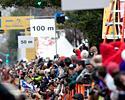 |
Contrary to what I originally thought, the toughest day in a stage race (at least for the technical director) is not a point-to-point road stage. "The most difficult day is the time trial. For the teams as well. Everyone is stretched really thin. It's because it is a relatively long road closure over a long period of time. And the key folks that I use are now spread out over 20 miles. On the road stages it depends on where we are and the road conditions. It is usually a question of balancing our needs as a race with the municipality being able to move vehicular traffic around."
But in the past couple of years, some stages have stretched resources a little thin like in Missouri and Georgia when breakaways put more than 20 minutes on the peloton. When considering that the roads close between 15 and 30 minutes before the arrival of the first car and that it might take another 20 minutes for the end of the race caravan of team cars (with each team having two), that translates into long waits for motorists trying to travel on their roads.
"On the stage into Rolla [Missouri] we came in with a 14-minute gap and we kept a major arterial road closed for longer than expected," explains Hodge. And once again, he is the one local officials call when things go wrong. As well, a big time gap into a finish with circuits poses additional worries for Hodge.
"What I never want to do is stop the field from coming onto a circuit. To have a city do all this work for a finish just to have 18 guys ride around it is tough for me to swallow," he says.
 |
With the huge number of vehicles involved in the race, there is always potential for something to go wrong. "There is always an issue with a team car every race. Last year our medical car died at Missouri. Our transportation coordinator handed off his vehicle and had to sit with that car until he was picked up!"
And then there is the parking of all those vehicles. "You don't think parking is a big deal until you show up to a place like Sausalito and try to fit 15 team busses into a tiny parking lot!
Understandably, the biggest nightmare for Hodge is having a rider injured, especially by something under his purview which happened at the Tour de Georgia in 2004. "The worst day I had racing was the day Craig Lewis was hit by a car. Everyone was mentally and physically exhausted when that happened. He is from my hometown and a great guy. That is my worst nightmare a rider getting hurt."
I want your job
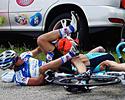 |
Well, if all of this sounds like fun, maybe you want to become a technical director. How does one go about becoming a technical director? Start small. "I came up as a grassroots criterium promoter. I think back to the first couple of races I did and cringe! In this job if I don't learn something new every day I am not doing my job. I think I've had 75 days of UCI racing since 2004... mistakes get made and we learn things."
"The big welcome to the world for me came with two events first, being the technical director for the 2000 Olympic trials. I got to meet officials from around the country and luckily learned from the right people.
"Then the 2004 Tour de Georgia, the first Lance year. Threshold had run the event well in 2003, [and] then we came in and took it over. But the amount of work that went into it just blew me away. We had a core of people who had done the Tour DuPont and Trumps, but that was it. I ran the technical duties AND the finish line crews, which was too much. After the first stage the finish line truck was leaking transmission fluid. By the time we got a new truck and transferred everything we drove straight to the next finish and built, barely in time. I think I slept six hours in three days!"
Seemingly before every sentence Hodge uttered about his job he noted how the people working around him make him look good. "I supervise course, security, medical, officials and a lot of different functional areas and I've been really lucky to find key people to manage those areas."
Photography
For a thumbnail gallery of these images, click here
- One of the worst parts of the job is when riders get injured.
- Choosing the start and finish towns is a large part of the planning.
- The trip through Fort Leonard Wood in Missouri was almost a snag when a miscommunication had the military expecting the race hours early.
- The time trials are the most chaotic for the race organisation.
- Unexpected things happen. Wonder whose insurance covers this?
Images by Mark Johnson
Images by Mark Zalewski/Cyclingnews.com


